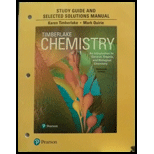
Concept explainers
(a)
To explain: The formation of magnesium ion by octet rule.
(a)
Answer to Problem 6.93UTC
Solution: Magnesium loses two electrons for the formation of magnesium ion
Explanation of Solution
According to the octet rule, atoms either accept or lose electrons to acquire stable noble gas configuration or completing their octets. Octet means a full set of eight valence electrons.
The number of electrons an atom can accept or lose depends on the valence electrons present in its neutral state. After accepting or losing electrons it will form ions which can be positively or negatively charged.
In the case of magnesium atom, the electronic configuration of magnesium atom is
By the octet rule,
(b)
To determine: Which noble gas has the same electron arrangement as the magnesium ion.
(b)
Answer to Problem 6.93UTC
Solution: The noble gas that has the same electron arrangement as the magnesium ion is the neon gas with atomic symbol Ne.
Explanation of Solution
The electronic configuration of magnesium atom is as follows:
Magnesium ion is formed by losing two electrons the resultant electronic configuration will be:
This is also the electron configuration of noble gas, Neon with atomic symbol Ne.
The noble gas with the electron configuration of magnesium ion is Neon.
(c)
To Explain: The large amount of formation of compounds with elements of Group 1A(1) and Group 2A(2) but not Group 8A (18) elements.
(c)
Answer to Problem 6.93UTC
Solution: Group 1A (1) and Group 2A(2) elements are found to be more reactive than Group 8 A(18) elements because Group1A and Group 2A tend to lose electrons as they have 1 and 2 electrons respectively in their outermost orbital. They lose these electrons to obtain noble gas configuration as per the octet rule. Group 8A elements are un-reactive or inert in nature because they already have complete octet.
Explanation of Solution
All elements try to obtain 8 valence electrons in their outer shell as per the octet rule. Group 1A includes hydrogen, lithium, sodium, potassium, rubidium, cesium and francium. All these elements have one electron in their outermost shell, which they try to lose to obtain the noble gas configuration. Group 2A has beryllium, magnesium, calcium, strontium, barium and radium. All these elements have two electrons in their outermost shell, which they try to lose to obtain the noble gas configurations.
Group 8A elements are noble gas elements consisting of helium, neon, argon, krypton and xenon which have 8 electrons each in their valence shell, so they are very stable. Hence, they are usually not reactive in nature and are also knownas inert elements.
Group 1A and Group 2A elements are more reactive than Group 8A elements.
Want to see more full solutions like this?
Chapter 6 Solutions
Study Guide And Selected Solutions Manual For Chemistry Format: Paperback
- Draw the mechanism to make the alcohol 2-hexanol. Draw the Mechanism to make the alcohol 1-hexanol.arrow_forwardDraw the mechanism for the formation of diol by starting with 1-pentanal in... basic conditions then acidic conditions then draw the mechanism for the formation of a carboxylic acid from your product.arrow_forwardIdentify each chiral carbon as either R or S. Identify the overall carbohydrates as L or Darrow_forward
- Ethers can be formed via acid-catalyzed acetal formation. Draw the mechanism for the molecule below and ethanol.arrow_forwardHOCH, H HO CH-OH OH H OH 11 CH₂OH F II OH H H 0 + H OHarrow_forwardDraw the mechanism for the formation of diol by starting with one pen and all in... basic conditions then acidic conditions then draw the mechanism for the formation of a carboxylic acid from your product.arrow_forward
 ChemistryChemistryISBN:9781305957404Author:Steven S. Zumdahl, Susan A. Zumdahl, Donald J. DeCostePublisher:Cengage Learning
ChemistryChemistryISBN:9781305957404Author:Steven S. Zumdahl, Susan A. Zumdahl, Donald J. DeCostePublisher:Cengage Learning ChemistryChemistryISBN:9781259911156Author:Raymond Chang Dr., Jason Overby ProfessorPublisher:McGraw-Hill Education
ChemistryChemistryISBN:9781259911156Author:Raymond Chang Dr., Jason Overby ProfessorPublisher:McGraw-Hill Education Principles of Instrumental AnalysisChemistryISBN:9781305577213Author:Douglas A. Skoog, F. James Holler, Stanley R. CrouchPublisher:Cengage Learning
Principles of Instrumental AnalysisChemistryISBN:9781305577213Author:Douglas A. Skoog, F. James Holler, Stanley R. CrouchPublisher:Cengage Learning Organic ChemistryChemistryISBN:9780078021558Author:Janice Gorzynski Smith Dr.Publisher:McGraw-Hill Education
Organic ChemistryChemistryISBN:9780078021558Author:Janice Gorzynski Smith Dr.Publisher:McGraw-Hill Education Chemistry: Principles and ReactionsChemistryISBN:9781305079373Author:William L. Masterton, Cecile N. HurleyPublisher:Cengage Learning
Chemistry: Principles and ReactionsChemistryISBN:9781305079373Author:William L. Masterton, Cecile N. HurleyPublisher:Cengage Learning Elementary Principles of Chemical Processes, Bind...ChemistryISBN:9781118431221Author:Richard M. Felder, Ronald W. Rousseau, Lisa G. BullardPublisher:WILEY
Elementary Principles of Chemical Processes, Bind...ChemistryISBN:9781118431221Author:Richard M. Felder, Ronald W. Rousseau, Lisa G. BullardPublisher:WILEY





